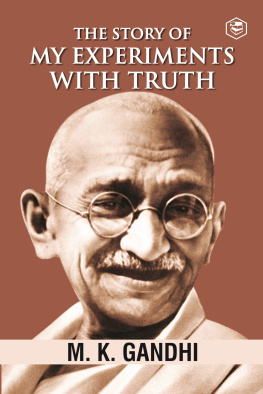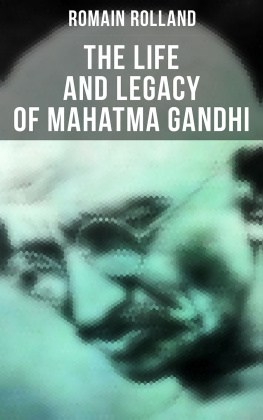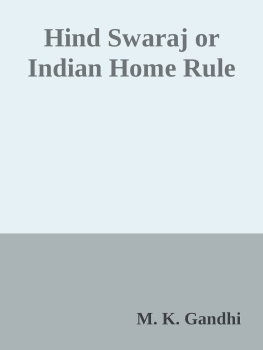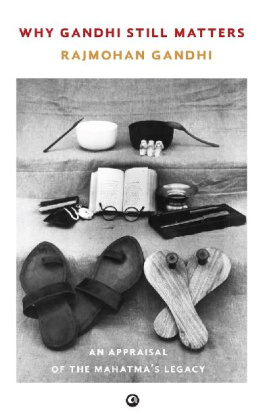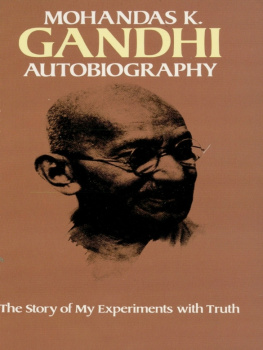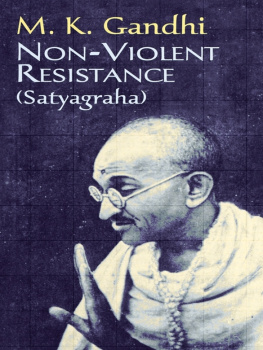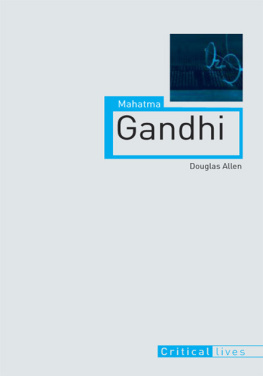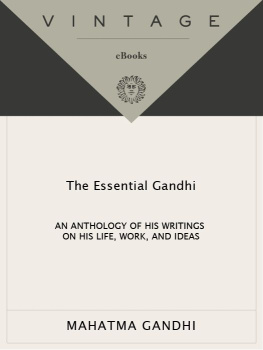Mahatma K. Gandhi - Non-Violent Resistance
Here you can read online Mahatma K. Gandhi - Non-Violent Resistance full text of the book (entire story) in english for free. Download pdf and epub, get meaning, cover and reviews about this ebook. year: 2001, publisher: Dover Publications, genre: Politics. Description of the work, (preface) as well as reviews are available. Best literature library LitArk.com created for fans of good reading and offers a wide selection of genres:
Romance novel
Science fiction
Adventure
Detective
Science
History
Home and family
Prose
Art
Politics
Computer
Non-fiction
Religion
Business
Children
Humor
Choose a favorite category and find really read worthwhile books. Enjoy immersion in the world of imagination, feel the emotions of the characters or learn something new for yourself, make an fascinating discovery.

- Book:Non-Violent Resistance
- Author:
- Publisher:Dover Publications
- Genre:
- Year:2001
- Rating:5 / 5
- Favourites:Add to favourites
- Your mark:
- 100
- 1
- 2
- 3
- 4
- 5
Non-Violent Resistance: summary, description and annotation
We offer to read an annotation, description, summary or preface (depends on what the author of the book "Non-Violent Resistance" wrote himself). If you haven't found the necessary information about the book — write in the comments, we will try to find it.
Non-Violent Resistance — read online for free the complete book (whole text) full work
Below is the text of the book, divided by pages. System saving the place of the last page read, allows you to conveniently read the book "Non-Violent Resistance" online for free, without having to search again every time where you left off. Put a bookmark, and you can go to the page where you finished reading at any time.
Font size:
Interval:
Bookmark:
NON-VIOLENT RESISTANCE (SATYAGRAHA)
BY MAHATMA K. GANDHI
Print ISBN 13: 978-1-4209-4990-2
eBook ISBN: 978-1-4209-4991-9
This edition copyright 2014
Please visit www.digireads.com
CONTENTS
Satyagraha means literally 'clinging to truth', and as Truth for Gandhiji was God, Satyagraha in the general sense of the word means the way of life of one who holds steadfastly to God and dedicates his life to Him. The true Satyagrahi is, accordingly, a man of God.
Such an individual in this world finds himself up against evil, which he cannot but resist. He comes across injustice, cruelty, exploitation and oppression. These he has to oppose with all the resources at his command. In his crusade his reliance is on Truth or God; and since the greatest truth is the unity of all life, Truth can be attained only by loving service of all, i.e. by non-violence. The weapon of the Satyagrahi is therefore non-violence. Satyagraha, in the narrower sense in which it is ordinarily understood, accordingly means resisting evil through soul-force or non-violence.
For the required soul-force the individual has to discipline himself in self-control, simplicity of life, suffering without fear or hatred, recognition of the unity of all living beings, and whole-hearted and disinterested service of one's neighbours. The vows which Gandhiji elaborated for members of his Satyagraha Ashram at Sabarmati are of interest from this point of view. They were truth, non-violence, brahmacharya, fearlessness, control of the palate, non-possession, non-stealing, bread-labour, equality of religions, anti-untouchability and swadeshi.
Gandhiji derived his doctrine of Satyagraha from many sources. It can be traced essentially to the Gita ideal of the karmayogin, and also to Jesus' Sermon on the Mount; and recently to the writings of Thoreau, Ruskin and more especially Tolstoy. But his practical application of it in the social and political spheres was entirely his own.
Satyagraha, in the narrower sense, takes many forms. Primarily it is a case of appealing to the reason and conscience of the opponent by inviting suffering on oneself. The motive is to convert the opponent and make him one's willing ally and friend. It is based on the idea that the moral appeal to the heart and conscience is, in the case of human beings, more effective than an appeal based on threat of bodily pain or violence. Indeed violence, according to Gandhiji, does not ever overcome evil; it suppresses it for the time being to rise later with redoubled vigour. Non-violence, on the other hand, puts an end to evil, for it converts the evil-doer.
But the non-violence which thus overcomes evil is not the passive resistance of the weak. The non-violence of a Satyagrahi is unflinching. It is the non-violence of the brave. It will lead the Satyagrahi to die with a smile on his lips and with no trace of hatred in his heart. It presupposes a disciplined character, selflessness and unswerving devotion to duty. The passive resister, or the one who adopts non-violence as policy, on the other hand, is really not non-violent, for he would be violent if he could, and is non-violent only because he does not for the time being have the means or the capacity for violence. It is a far cry, therefore, from passive resistance to Satyagraha.
Satyagraha may take the form of non-co-operation. When it does, it is not non-co-operation with the evil-doer but with his evil deed. This is an important distinction. The Satyagrahi cooperates with the evil-doer in what is good, for he has no hatred for him. On the contrary, he has nothing but friendship for him. Through cooperating with him in what is not evil, the Satyagrahi wins him over from evil.
Satyagraha may at times take the form of fasting, When it does, there is to be no trace of self in the motive. The fast should be prompted by the highest devotion to duty and love for the opponent. It should aim at purifying oneself, for lack of capacity to convince the opponent shows defect in oneself. It should seek to influence the opponent by converting him, not by coercing him to do something against his conviction. Fasting should be undertaken, according to Gandhiji, only when one is thoroughly convinced of the Tightness of one's stand, when all other methods have failed, and as a last resort, and never for personal gain. It should be in the nature of prayer for purity and strength and power from God.
Satyagraha in the political sphere assumes the form of Civil Disobedience. It is for this form of Satyagraha that Gandhiji came to be most reputed. It means mass resistance on a non-violent basis against the Government when negotiations and constitutional methods have failed. It is called 'civil' because it is non-violent resistance by people who are ordinarily law-abiding citizens; also because the laws which they choose to disobey are not moral laws but only such as are harmful to the people. It is civil also in the sense that those who break the law are to observe the greatest courtesy and gentleness in regard to those who enforce the law. They are even to seek not to embarrass the opponent if possible.
Gandhiji organized such Satyagraha for the first time in South Africa against humiliating laws enforced by the South African Government on Indians in that country. With the experience so gained, he organized successfully peasant Satyagraha in Champaran, Kheda, and Bardoli to remove specific local grievances.
But Satyagraha can also be on a nation-wide scale to resist an entire Government when that Government is corrupt and demoralizes the people. It may then take the form of non-co-operation with the Government, as it did in Gandhiji's Civil Disobedience movements of 1920-22, 1930-34 and 1940-44 in India. Non-co-operation may express itself in giving up titles and honours bestowed by the Government, resignation from Government service, withdrawal from the police and military, non-payment of taxes, boycott of courts, schools and legislatures, and running parallel institutions to perform these functions. Gandhiji, however, was very cautious in regard to some of these forms of non-co-operation, as they were likely to bring down on the people the wrath of an indignant Government, and he did not want the people to suffer more than was necessary from Government repression.
Such Civil Disobedience demands on the part of the people disciplined group action, infinite capacity for suffering without retaliation, and strict obedience to leaders. As this discipline and obedience are not, as in the case of the military, based on force, the leaders have to be men of character and public service, whom the people respect and willingly obey. This implies that the leaders are men who generally carry on various forms of constructive service for the people. Gandhiji, therefore, emphasized working of his Constructive Programme as essential for Satyagraha; and not only for this reason, but also because discipline and group action need to be built up steadily among the people. They have to be taught, for example, cooperation, communal unity, fearlessness, consideration for the social good, self-help and resourcefulness, and have to have physical, mental and moral strength. All this can be done only through various forms of constructive endeavour advocated by Gandhiji, such as working for economic self-sufficiency in villages; education, abolition of drink and untouchability, communal concord, uplift of women, sanitation, hygiene, improved diet, child welfare, and so on. Satyagraha in the political sphere is not, therefore, a plan of action adopted merely for a time, wound up thereafter, and requiring no further effort; it presupposes day to day non-political constructive work aiming at the all-around development of the individual from the cradle to the grave.
In this respect Satyagraha or non-violent resistance, as conceived by Gandhiji, has an important lesson for pacifists and war-resisters of the West. Western pacifists have so far proved ineffective because they have thought that war can be resisted by mere propaganda, conscientious objection, and organization for settling disputes. Gandhiji showed that non-violence to be effective requires constructive effort in every sphere of life, individual, social, economic and political. These spheres have to be organized and refashioned in such a way that the people will have learnt to be non-violent in their daily lives, manage their affairs on a cooperative and non-violent basis, and thus have acquired sufficient strength and resourcefulness to be able to offer non-violent resistance against organized violence. The practice of non-violence in the political sphere is not, therefore, a mere matter of preaching or even of establishing arbitration courts or Leagues of Nations, but involves building up brick by brick with patience and industry a new non-violent social and economic order. It depends ultimately on banishing violence from the heart of the individual, and making of him a transformed disciplined person. Gandhiji's contribution lay in evolving the necessary technique and showing by example how all this can be done.
Next pageFont size:
Interval:
Bookmark:
Similar books «Non-Violent Resistance»
Look at similar books to Non-Violent Resistance. We have selected literature similar in name and meaning in the hope of providing readers with more options to find new, interesting, not yet read works.
Discussion, reviews of the book Non-Violent Resistance and just readers' own opinions. Leave your comments, write what you think about the work, its meaning or the main characters. Specify what exactly you liked and what you didn't like, and why you think so.

